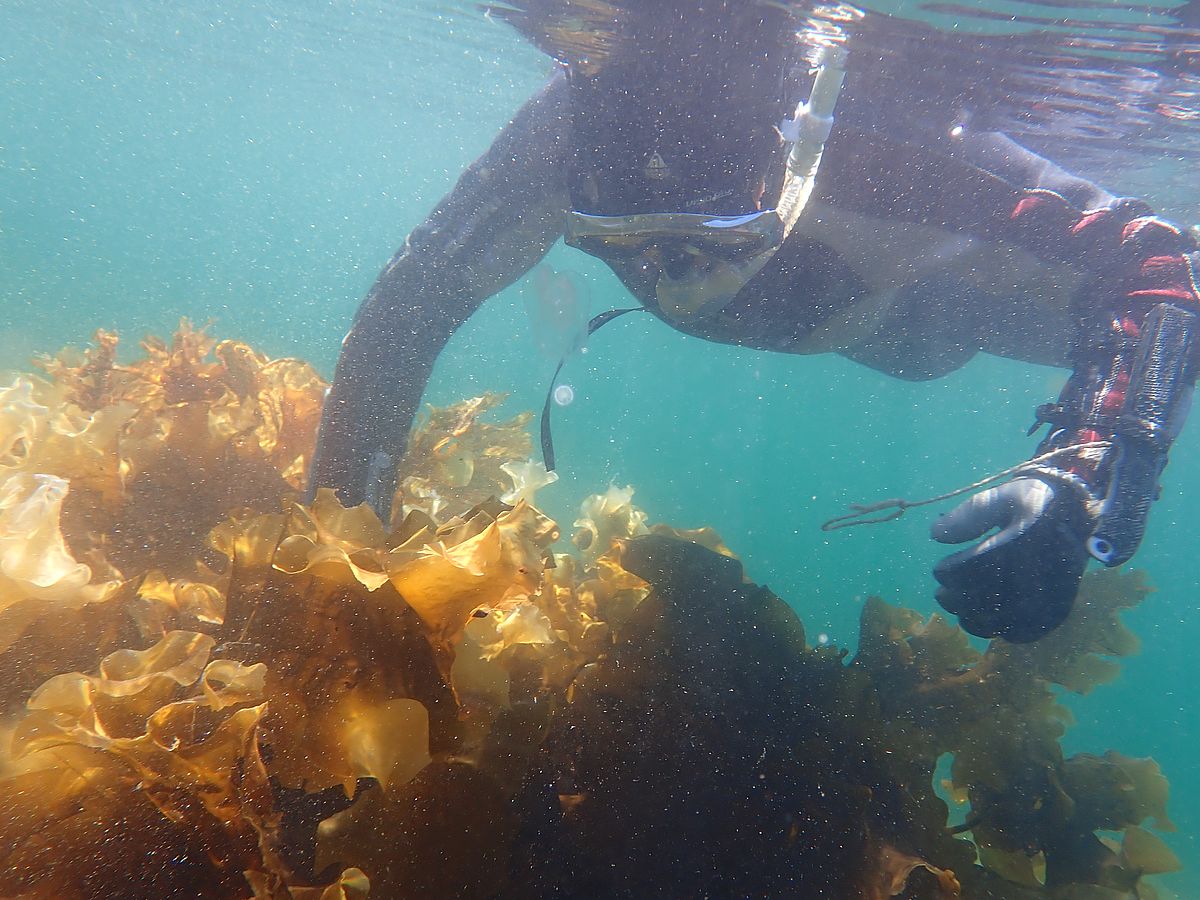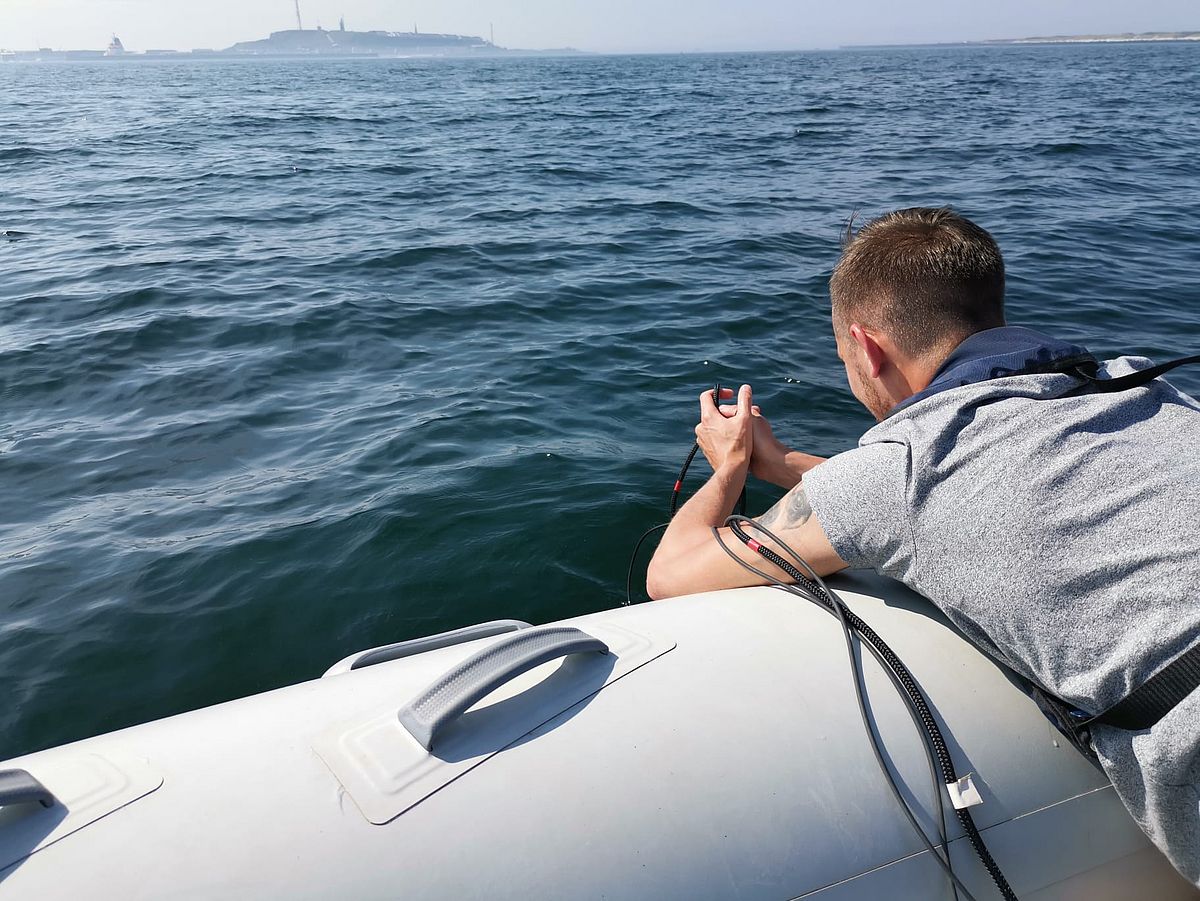Expeditions

Greenland 2023
Future kelp forest communities of Greenland: As part of the FACE-IT project, Nora and Sarina conducted a field work campaign in Nuuk, Greenland in June / July 2023 to answer the question, how future Arctic kelp forest communities might look like. Therefore, they run a multi-factorial experiment in cooperation with Thomas Juul-Pedersen and Tobias Vonnahme from the Greenland Institute for Natural Resources (Pinngortitaleriffik), testing not only the influence of increased temperature but also altered light conditions on two kelp species. They compared eco-physiological and biochemical responses of the Arctic species Agarum clathratum and the cold-temperate species Saccharina latissima.

Porsangerfjord 2022
In summer 2022, Simon and Nora traveled to the Holmfjord Research Station (run by the Norwegian Institute of Marine Research Havforskningsinstituttet) on the east coast of the Porsangerfjord, one of Norway's northernmost fjords. As part of the EU Horizon 2020 project FACE-IT, we collected different kelp species to compare the biochemical and genomic profiles of kelps from different Arctic sites. In addition, we focused on the diversity of fauna found there with the aim of setting up a "barcode library" of the study site for future projects and dove more into zoology with a sea urchin grazing experiment in collaboration with Marie Koch from AWI. Back in Germany, fresh material from Laminaria hyperborea and L. digitata were used in a multi-factorial experiment to investigate the effects of climate change on its dispersal potential in the Arctic.

Vietnam 2022
“Sustainable approaches of aquaculture, such as co-culture and the husbandry of organisms low in the food web, have a long tradition in Asia and the direct consumption of algae is a regular part of the people´s diet.”
In cooperation with the “SeaGrapes” project of the Leibniz Centre for Tropical Marine Research , ZMT (https://www.leibniz-zmt.de/en/research/research-projects/seagrapes.html), a three-month research stay was conducted in Nha Trang, Vietnam. The aim of several field- and laboratory studies was to explore possible co-cultivation approaches of the edible green alga Caulerpa lentillifera, also known as sea grapes or “green caviar”, together with other low-trophic marine organisms like high value red algae (Kappaphycus alvarezii) and fed aquaculture species (the edible marine snail Babylonia areolata).

Helgoland 2022
This summer the first Heligoland expedition of the project sea4soCiety (https://sea4society.cdrmare.de/en/) took place. Within this project, which is part of the research mission CDRmare (https://cdrmare.de/en/), we investigate options for the afforestation of kelp forests in the German Bight. During the first cruise with the research vessel Littorina we took radiation measurements at several locations of kelp forests around the island. Furthermore, we collected fresh samples of the kelp Laminaria hyperborea to determine their photosynthetic activity and light demands. These data will help us to better understand the local conditions of kelp forests around Heligoland and the required conditions for potential afforestation sites. A short documentary about the sea4soCiety expedition to Heligoland can be seen in the NDR mediathek (https://www.ndr.de/nachrichten/schleswig-holstein/salty-FiSH-Kelpwaelder-vor-Helgoland,saltyfish104.html). We further obtained fertile L. hyperborea samples in January which we cultivated in our lab in Bremen. After a few weeks, the first sporophytes were visible, and we continue to cultivate these for future experiments.

Svalbard 2021
We are back to Svalbard! After the pandemic-related break we returned to Kongsfjorden. In the frame of the EU H2020 project FACE-IT we study the impact of terrestrial sedimental run-off on underwater light climate, light availablity and, consequently, photosynthesis, productivity and vertical distribution of seaweeds. We will also collect kelp samples for comparative analyses of biochemical and genomic profiles across the various FACE-IT study sites. Furthermore, we contribute to surveys of the seaweed-associated fauna.
Svalbard 2019
We are back at Kongsfjorden. In the current summer campaign we will focus on the interactive effects of radiation, temperature, salinity and nutrient concentration on seaweed ecophysiology. For Nora Diehl the studies at Kongsfjorden represent the northernmost station of her large-scale project on the impact of heatwaves on the kelp Saccharina latissima along its latitudinal range of distribution. On Svalbard, Johanna Marambio conducts those experiments on temperature and light interaction on the brown seaweed Desmarestia aculeata and the red Palmaria palmata, which she is going to repeat in Antarctica in December 2020. The comparison of related species from regions with different climate history will allow for insights into the evolutionary base of physiologial adaptation strategies.
Norway 2018
In June 2018 Nora Diehl and Britta Meyer-Schlosser collected specimens of the kelp Saccharina latissima at five locations along the north-south gradient of the Norwegian coastline. Determination of a biochemical "Status Quo" should reveal local acclimation and adaptation characteristics pointing to ecotypic differentiation. This "Status Quo“ will be compared to the biochemical characteristics of S. latissima from Helgoland, France, Portugal and Svalbard. In addition, samples of S. latissima were collected for experiments on temperature stress. These studies will give new insights into local adaptation and intra-specific differences in acclimation patterns along the latitudinal gradient of the European coastline.
Chile 2017
In the frame of our DFG project SINVA (Probability of seaweed invasions into Antarctica) we are conducting habitat mapping and ecophysiological experiments for two species of invasive red algae in the South of Chile. For this we are cooperating closely with the colleagues from the Universidad de Magallanes in Punta Arenas. Data on physiological tolerance of the algae and meteorological and geographical habitat descriptors will be implemented in species distribution models to predict whether species invasive to Patagonia are likely to establish at the Antarctic Peninsula.
Svalbard 2016/2017
During the Svalbard campaign 2016/17 we focus on the physiological adaptation mechanisms of kelp to the extrem saisonality of abiotic drivers in the high Arctic. On Svalbard at approx. 80° N, these perennial and primarily photoautotrophic organisms have to endure several months of darkness during the polar night. To some high Arctic species the polar night also represents the main periode for growth. During two expeditions, at the end of summer and winter, respectively, we investigate how photosynthesis and carbon metabolism are triggered by saisonality and how responses might be modulated by the current warming of the Arctic Ocean.
Svalbard 2015
In summer 2015 we will characterise the underwater light regime within the kelp forest of Kongsfjorden and do simulations in the laboratory. By this we will clarify to what extent the parental canopy protects reproductive stages of the kelp Alaria esculenta against harmful UV-radiation. In adition to flux-dependent recruitment we will assess photosynthesis and physiological and biochemical responses of algal spores to different radiation regimes.
Sargasso Sea 2015
As current reports indicate the declining abundance of the floating brown alga Sargassum natans in the Sargasso Sea we will explore algal stress physiology during a cruise onboard the research vessel Maria S. Merian (MSM 41). By conducting multifactorial stress analyses including the combined effects of temperature and irradiance we will investigate whether there are physiological reasons for the apparent decline in algal abundance.
New Zealand 2014
During our research stay in New Zealand (Hamilton, Tauranga, Dunedin) we explored different features of the invasive Asian kelp Undaria pinnatifida. In field and tank experiments we investigated the contribution of artificial hard substrates to the spread of the alga. In a lab experiment we characterized the physiological tolerance of U. pinnatifida to variation in temperture and salinity in comparison to native kelps.
Svalbard 2014
This summer we investigated the phenomenon of cross-acclimation in the kelps Alaria esculenta and Saccharina latissima from Kongsfjorden. Cross-acclimation entails that acclimation to one specific enviromental driver is linked to a higher tolerance towards another (stress-)factor. By the related experiments we will be able to discriminate general vs. driver-specific responses, and also get insight how algae perceive their environment. In field and lab experiments we were able to demonstrate multiple stress- and species-specific responses. For the kelp Alaria esculenta acclimation to lower salinities was linked to a higher tolerance towards ultraviolet radiation.
Papua New Guinea 2014
Our work in Papua New Guinea is focussed to the combined effects of ocean acidification and high CO2 concentration interacting with other drivers (irradiance, nutrient loads) on calcifying seaweeds growing in the vicinity of natural CO2 seeps. These vent sites offer unique conditions to study CO2 effects on marine benthic communities. In combination with targeted lab experiments we will be able to characterise the interactive effects of acidification and other stresors. This will improve predictions on how marine organisms and communities will respond to further CO2 increase in the 21st centuary.
Punta Arenas / Chile 2014
During our research stay in Punta Arenas, Chile, we have explored ecological and physiological short-term responses of the brown seaweeds Macrocystis pyrifera and Durvillaea antarctica during floatation on the water surface. In addition we studied photo acclimation of M. pyrifera fronds along the depth gradient.










